Multidimensional Characteristics of Design-Based Engineering Learning: A Grounded Theory Study
Abstract
1. Introduction and Background
2. Research Methods and Data Collection
2.1. Grounded Theory
2.2. Purposeful Sampling
2.3. Interview Design and Implementation
3. Data Coding and Analysis
3.1. Open Coding
3.2. Axial Coding
3.3. Selective Coding
3.4. Test of Theoretical Saturation
4. Results and Discussion
4.1. Design Practice
Sometimes the teacher tells me a lot of things, and I listen to the fog, then forget. However, for a specific example in the course, if I do it by hand, I will be deeply impressed after the experience, and then I will know how to go further after I find the problem, so practice is very important.(S3)
Engineering design is biased towards practice. Through the design scheme and physical model, I fully practice the engineering knowledge I have learned.(S7)
For engineering students, practical ability should be the most basic. It is very effective to cultivate students’ practical ability in design-related practical projects, which can help students simulate the engineering environment.(T03)
Our philosophy is that students in the lower grades should be exposed to robots early. Students will understand the difficult points, key points, and core points of robots in practice. When students have a basic understanding of the whole knowledge point, and then go back to learning machinery, computers, and other related courses, students will know how to combine relevant knowledge to solve engineering problems.(T07)
4.2. Interactive Reflection
The process of completing the design task usually involves the cooperation of students from multiple majors. Students from different majors will be responsible for different modules. In the process of task docking, there must be a lot of work in communication and connection, and interaction is very common.(S9)
The biggest goal of group cooperation is to obtain more satisfactory results after constantly revising the program!(S13)
We don’t care about the form of classroom teaching but focus on the content and effect of the lecture, which is the most fundamental. The reality is that students are more likely to take the initiative to learn, be inspired, and gain from cooperation. I think teamwork is very effective.(T05)
4.3. Knowledge Integration
I was deeply impressed when I finished the big design assignment. One of my classmates directly made a small program of an artificial intelligence volleyball team, in which two volleyball teams designed by him could play together. This program requires a lot of knowledge, and I admire it. It seems that to make a great thing, one must have strong knowledge integration ability, this requirement is very high.(S1)
I think knowledge integration is crucial in the realization of engineering design. The design process is not monolithic, but multidisciplinary, and you need to constantly evaluate how students are applying their knowledge, and provide appropriate guidance based on feedback.(T3)
4.4. Circular Iteration
Engineering and design is a process of trial and error. Experience has taught me that trial and error have a cost. If I obtain results after some tries, then I will be happy. If I keep trying and making errors without finding a solution, I find the process very boring.(S7)
Sometimes I get caught up in self-inspired learner mode, where I’ve spent a lot of time but the feedback isn’t satisfactory. There is definitely a problem with this process. You may think you have learned it, but you may not have understood it at all. At this time, we need to reflect on our own practice process and then communicate with classmates to understand the reasons, and finally establish a connection with the knowledge system, or apply it to practical problems.(S1)
Design-oriented curriculum teaching emphasizes a closed loop in teachers’ instructional design before, during, and after class, as well as a self-cycle in students’ individual learning.(T6)
4.5. Operational Definition
5. Conclusions
5.1. Theoretical Contributions
5.2. Practical Enlightenment
5.3. Limitations and Prospects
Author Contributions
Funding
Institutional Review Board Statement
Informed Consent Statement
Data Availability Statement
Conflicts of Interest
Appendix A
- (1)
- What do you think is the position of design-based engineering learning in engineering education?
- (2)
- From your teaching and management experience, what principles should be followed in the implementation of design-based engineering teaching, and what kind of learning environment should be created?
- (3)
- Based on your teaching and management experience, can design-based engineering learning improve the learning outcomes of engineering students, and what is the key to improving their performance?
- (4)
- According to your teaching and management experience, what difficulties have you encountered in teaching engineering design courses? How was it solved?
- (5)
- What are the key elements to the success of design-based engineering learning besides the efforts of teachers?
- (6)
- What do you think is the development stage of design-based engineering learning in China compared with foreign countries? What foreign countries are worth our learning and referencing?
- (7)
- What are your suggestions for the development of design-based engineering learning in China?
- (8)
- How does the Teaching Steering Committee of Chinese colleges and universities promote the development of design-based engineering learning?
Appendix B
- (1)
- Have you ever participated in design-based engineering studies during your four years at university?
- (2)
- Can you introduce the situation of the learning project that you participated in (participation mode and period, course content, teaching method, organization method, the evaluation method of student learning outcomes, etc.)?
- (3)
- What do you think are the main points and characteristics of design-based engineering learning? Can you describe your learning process, the key stages and key events in your learning of design-based engineering?
- (4)
- What problems and challenges have you experienced in the learning process? How did you solve it? Could you share with me in detail the process of solving this problem?
- (5)
- How did you communicate with team members during the learning process of design-based engineering? What benefited most from communication with team members?
- (6)
- Do you think the practice of design-based engineering learning in your current major can meet your needs for employment or further study in the future? If not, what are the problems? How can it be improved?
- (7)
- Are you satisfied with the supply of various teaching resources and organizational management provided by colleges and universities? If not, what are your suggestions?
References
- Wang, P.; Gu, J.; Liu, W. Foundation of Engineering Education; Higher Education Press: Beijing, China, 2015. [Google Scholar]
- Xiang, C. Engineering Learning: Model Change and Theoretical Interpretation. Res. High. Educ. Eng. 2015, 4, 55–63. [Google Scholar]
- Stevens, R.; O’Connor, K.; Garrison, L.; Jocuns, A.; Amos, D.M. Becoming an Engineer: Toward a Three Dimensional View of Engineering Learning. J. Eng. Educ. 2008, 97, 355–368. [Google Scholar] [CrossRef]
- Litzinger, T.; Lattuca, L.R.; Hadgraft, R.; Newstetter, W. Engineering Education and the Development of Expertise. J. Eng. Educ. 2011, 100, 123–150. [Google Scholar] [CrossRef]
- Zheng, J.; Xing, W.; Zhu, G.; Chen, G.; Zhao, H.; Xie, C. Profiling self-regulation behaviors in STEM learning of engineering design. Comput. Educ. 2019, 143, 103669. [Google Scholar] [CrossRef]
- Wallace, K. Educating Engineers in Design: Lessons Learnt from the Visiting Professor’s Scheme; The Royal Academy of Engineering: London, UK, 2005. [Google Scholar]
- Stanton, N.A.; Salmon, P.M.; Rafferty, L.A.; Walker, G.H.; Baber, C.; Jenkins, D.P. Human Factors Methods: A Practical Guide for Engineering and Design; CRC Press: Boca Raton, FL, USA, 2017. [Google Scholar]
- Cross, N. Engineering Design Methods: Strategies for Product Design; John Wiley & Sons, Harper & Row: New York, NY, USA, 2000. [Google Scholar]
- Yin, R.Y.; Wang, Y.L.; Li, B.C. Engineering Philosophy; Higher Education Press: Beijing, China, 2013; pp. 174–175. [Google Scholar]
- Caws, P.; Mitcham, C. Thinking through Technology: The Path between Engineering and Philosophy; The University of Chicago Press: Chicago, IL, USA, 1994. [Google Scholar]
- Naomasa, N. Automatic Design; Marushan: Tokyo, Japan, 1971. [Google Scholar]
- Hershauer, R.B.J.C. The new science of management decision, revised edition; Review by: Henry Mintzberg. Aca Manag. Rev. 1977, 3, 161–162. [Google Scholar]
- Kimbler, D.L.; Watford, B.A.; Davis, R.P. Symbolic modelling and design methodology. Des. Stud. 1988, 9, 208–213. [Google Scholar] [CrossRef]
- Sheppard, S.; Jenison, R. Examples of freshman design education. Int. J. Eng. Educ. 1997, 13, 248–261. [Google Scholar]
- Benton, M.; Seireg, A. Factors Influencing Instability and Resonances in Geared Systems. J. Mech. Des. 1981, 103, 372–378. [Google Scholar] [CrossRef]
- Willem, R.A. On knowing design. Des. Stud. 1988, 9, 223–228. [Google Scholar] [CrossRef]
- National Academy of Engineering (NAE). The Engineer of 2020; The National Academies Press: Washington, DC, USA, 2004. [Google Scholar]
- Miranda, J.; Navarrete, C.; Noguez, J.; Molina-Espinosa, J.-M.; Ramírez-Montoya, M.-S.; Navarro-Tuch, S.A.; Bustamante-Bello, M.-R.; Rosas-Fernández, J.-B.; Molina, A. The core components of education 4.0 in higher education: Three case studies in engineering education. Comput. Electr. Eng. 2021, 93, 107278. [Google Scholar] [CrossRef]
- Li, P.G.; Xu, X.D.; Chen, G.S. Research on problems and Reasons of Chinese undergraduate engineering education practice. Adv. Mater. Res. 2012, 433–440, 1535–1539. [Google Scholar]
- Osgood, L.; Johnston, C.R. Design and Engineering: A Classification and Commentary. Educ. Sci. 2022, 12, 232. [Google Scholar] [CrossRef]
- Seely, B.E. Patterns in the history of engineering education reform: A brief essay. In Educating the Engineer of 2020: Adapting Engineering Education to the New Century; National Academy of Science: Washington, DC, USA, 2005; pp. 114–130. [Google Scholar]
- Rolstadås, A.; Browne, J. New Challenges in Manufacturing Engineering Education; Recent Advances in Mechanical Engineering; Springer: Singapore, 2023; pp. 45–54. [Google Scholar]
- Goel, A.K.; Garza, A.G.D.S.; Grué, N.; Murdock, J.W.; Recker, M.M.; Govindaraj, T. Towards design learning environments—I: Exploring how devices work. In Intelligent Tutoring Systems; Springer: Berlin/Heidelberg, Germany, 1996; pp. 493–501. [Google Scholar] [CrossRef]
- Kolodner, J.L. Facilitating the Learning of Design Practices: Lessons Learned from an Inquiry into Science Education. J. Ind. Teach. Educ. 2002, 39, 9–40. [Google Scholar]
- Mehalik, M.M.; Schunn, C. What Constitutes Good Design? A Review of Empirical Studies of Design Processes. Int. J. Eng. Educ. 2006. [Google Scholar]
- Nelson, C.E. Critical thinking and collaborative learning. New Dir. Teach. Learn. 1994, 1994, 45–58. [Google Scholar] [CrossRef]
- Hadgraft, R.G.; Kolmos, A. Emerging learning environments in engineering education. Australas. J. Eng. Educ. 2020, 25, 3–16. [Google Scholar] [CrossRef]
- Dym, C.L.; Shames, I.H. Introduction to the Calculus of Variations; Chapman & Hall: New York, NY, USA, 2013. [Google Scholar]
- Polishetty, A.; Chandrasekaran, S.; Goldberg, M.; Littlefair, G.; Steinwedel, J.; Stojcevski, A. Enhancing student learning outcomes in manufacturing engineering through design based learning. In Proceedings of the Australian Association of Engineering Education 2014 Conference, Wellington, New Zealand, 8–12 December 2014. [Google Scholar] [CrossRef]
- Johri, A.; Olds, B.M. Situated Engineering Learning: Bridging Engineering Education Research and the Learning Sciences. J. Eng. Educ. 2011, 100, 151–185. [Google Scholar] [CrossRef]
- Kimmel, S.J.; Deek, F.P.; Kimmel, H.S. Using a Problem-Solving Heuristic to Teach Engineering Graphics. Int. J. Mech. Eng. Educ. 2004, 32, 135–146. [Google Scholar] [CrossRef]
- Lee, C.-S.; Su, J.-H.; Lin, K.-E.; Chang, J.-H.; Lin, G.-H. A Project-Based Laboratory for Learning Embedded System Design With Industry Support. IEEE Trans. Educ. 2009, 53, 173–181. [Google Scholar] [CrossRef]
- Tempelman, E.; Pilot, A. Strengthening the link between theory and practice in teaching design engineering: An empirical study on a new approach. Int. J. Technol. Des. Educ. 2010, 21, 261–275. [Google Scholar] [CrossRef]
- Xiang, C. Research on Design-Based Engineering Learning; South China University of Technology Press: Guangzhou, China, 2016. [Google Scholar]
- Starkey, J.M.; Midha, A.; DeWitt, D.P.; Fox, R.W. Experiences in the integration of design across the mechanical engineering curriculum. In Proceedings of the 1994 IEEE Frontiers in Education Conference, San Jose, CA, USA, 2–6 November 1994; pp. 464–468. [Google Scholar] [CrossRef]
- Little, P.; Cardenas, M. Use of Studio Methods In The Introductory Engineering Design Curriculum. J. Eng. Educ. 2020, 90, 309–318. [Google Scholar] [CrossRef]
- Gu, P.; Hu, W.; Lu, X.; Bao, N.; Lin, P. From CDIO in China to CDIO in China: Development path, Influence and reasons. Res. High. Educ. Eng. 2017, 1, 24–43. [Google Scholar]
- Li, H.; Zhu, A.; Chen, T.; Zhang, Y. Research on Teaching Practice of engineering design ability Cultivation based on Design thinking. Res. High. Educ. Eng. 2022, 3, 85–90. [Google Scholar]
- Jin, X.; Li, L.; Du, J.; Qiu, Y. Teaching Innovation Design Based on BOPPPS Model—A Case study of “Mechanical Design” course. Res. High. Educ. Eng. 2022, 6, 19–24. [Google Scholar]
- Zhang, Z.; Zhang, G.; Zhu, J. Innovation design ability Cultivation based on Kolb experiential Learning Cycle. Res. High. Educ. Eng. 2020, 1, 74–78, 136. [Google Scholar]
- Li, P.; Xu, X.; Chen, G. Analysis of problems and causes of practical teaching of undergraduate engineering education in China. Res. High. Educ. Eng. 2012, 3, 1–6. [Google Scholar]
- Strauss, A.; Corbin, J. Grounded Theory Methodology: An Overview Handbook of Qualitative Research; Sage Publications: New York, NY, USA, 1994. [Google Scholar]
- Glaser, B.G.; Strauss, A.L. The Discovery of Grounded Theory: Strategies for Qualitative Research; Routledge: New York, NY, USA, 1967. [Google Scholar]
- Wuelser, G.; Pohl, C. How researchers frame scientific contributions to sustainable development: A typology based on grounded theory. Sustain. Sci. 2016, 11, 789–800. [Google Scholar] [CrossRef] [PubMed]
- McDonald, S. Studying actions in context: A qualitative shadowing method for organizational research. Qual. Res. 2005, 5, 455–473. [Google Scholar] [CrossRef]
- Kelemen, M.; Rumens, N. Pragmatism and heterodoxy in organization research: Going beyond the quantitative/qualitative divide. Int. J. Organ. Anal. 2012, 20, 5–12. [Google Scholar] [CrossRef]
- Goulding, C. Grounded theory: The missing methodology on the interpretivist agenda. Qual. Mark. Res. Int. J. 1998, 1, 50–57. [Google Scholar] [CrossRef]
- Sebastian, K. Distinguishing between the Strains Grounded Theory: Classical, Interpretive and Constructivist. J. Soc. 2019, 3, 1–9. [Google Scholar]
- Strauss, A.L.; Corbin, J.M. Basics of Qualitative Research: Techniques and Procedures for Developing Grounded Theory; Sage Publications: Thousand Oaks, CA, USA, 1998. [Google Scholar]
- Charmaz, K.C. Constructing Grounded Theory: A Practical Guide Through Qualitative Analysis; Pine Forge Press: Thousand Oaks, CA, USA, 2006. [Google Scholar]
- Strauss, A.L. Qualitive Analysis for Social Scientists; Cambridge University Press: Cambridge, UK, 1987. [Google Scholar]
- Ligita, T.; Harvey, N.; Wicking, K.; Nurjannah, I.; Francis, K. A Practical Example of Using Theoretical Sampling throughout a Grounded Theory Study: A Methodological Paper. Qual. Res. J. 2019, 20, 116–126. [Google Scholar] [CrossRef]
- Guest, G.; Bunce, A.; Johnson, L. How Many Interviews Are Enough? An Experiment with Data Saturation and Variability. Field Methods 2006, 18, 59–82. [Google Scholar] [CrossRef]
- Thomas, S.P.; Pollio, H.R. Listening to patients: A phenomenological approach to nursing research and practice. J. Adv. Nurs. 2010, 42, 539. [Google Scholar]
- Creswell, J.W. Qualitative Inquiry and Research Design: Choosing among Five Traditions; Sage Publications: Thousand Oaks, CA, USA, 1998. [Google Scholar]
- Boyd, C.O. Philosophical foundations of qualitative research. In Nursing Research: A Qualitative Perspective; Jones & Bartlett Learning: Burlington, MA, USA, 1993; pp. 66–93. [Google Scholar]
- Saunders, B.; Sim, J.; Kingstone, T.; Baker, S.; Waterfield, J.; Bartlam, B.; Burroughs, H.; Jinks, C. Saturation in qualitative research: Exploring its conceptualization and operationalization. Qual. Quant. 2018, 52, 1893–1907. [Google Scholar] [CrossRef]
- Edhlund, B.; McDougall, A. NVivo 12 Essentials; Lulu Press: Morrisville, NC, USA, 2018. [Google Scholar]
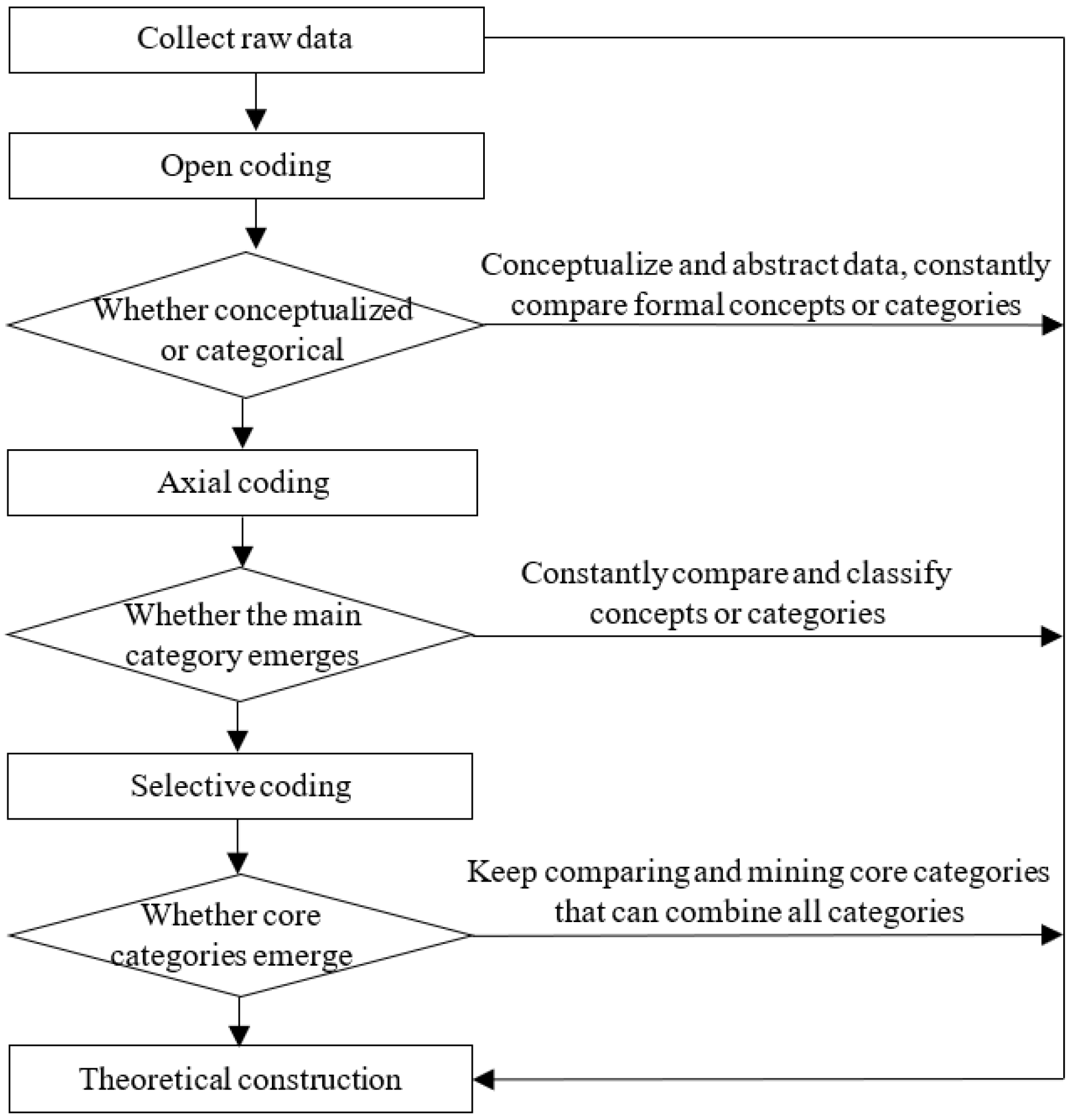
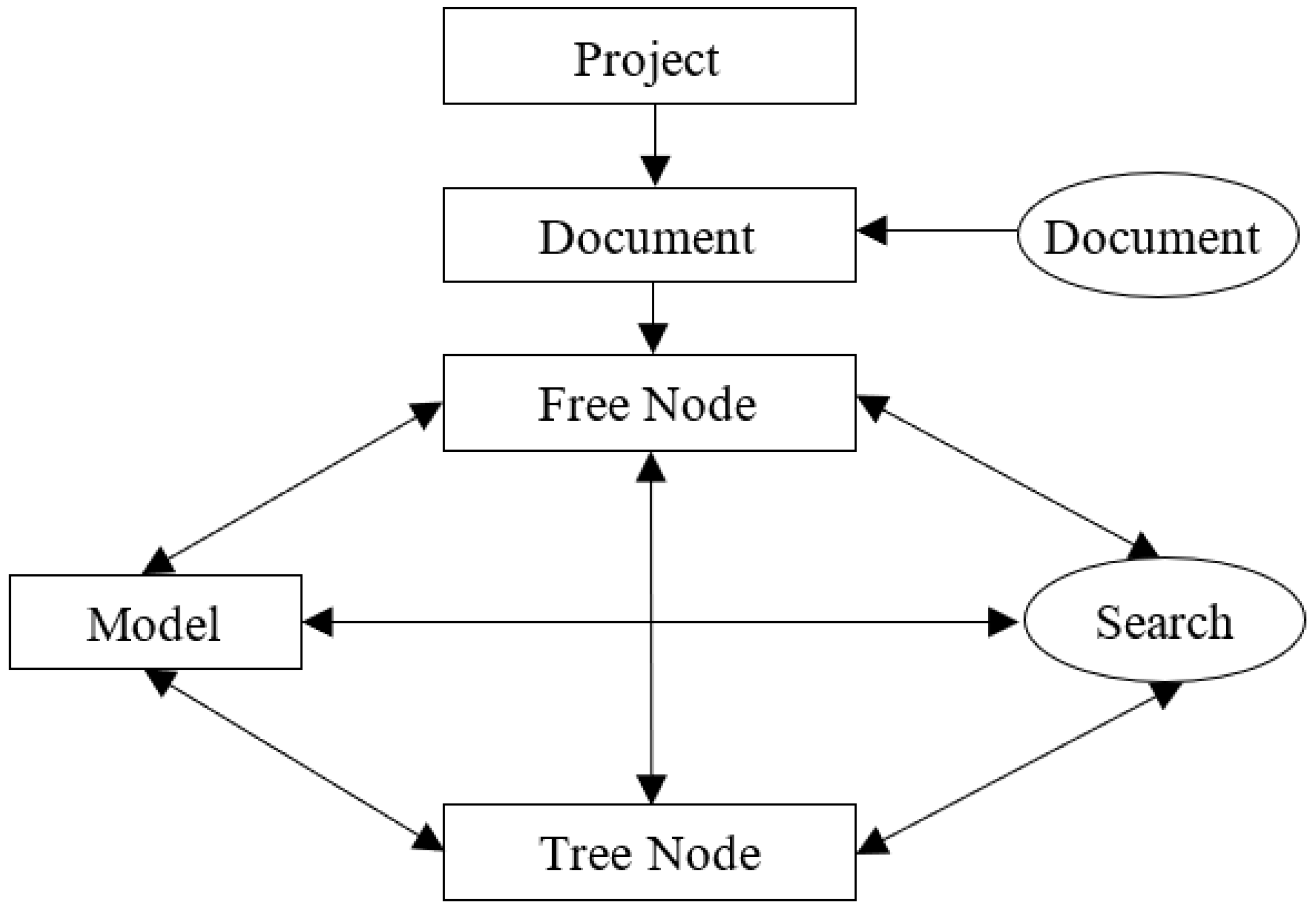

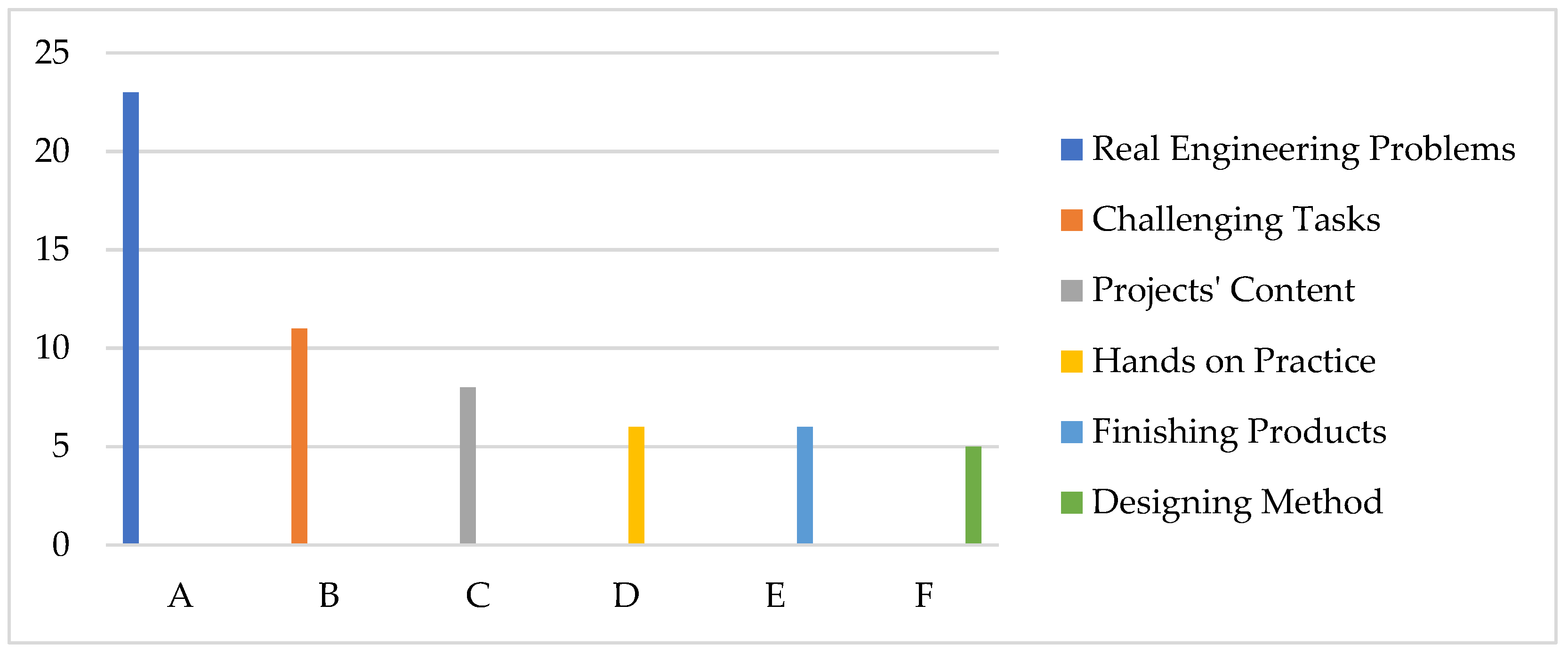
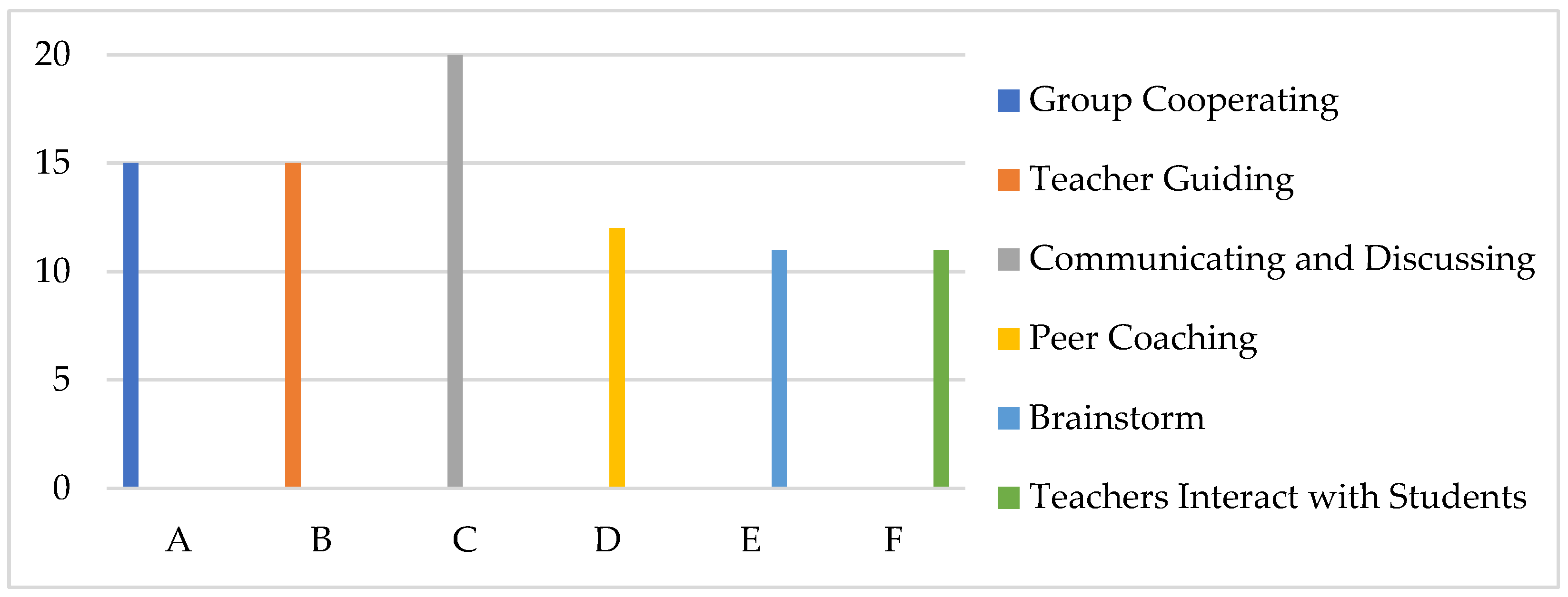
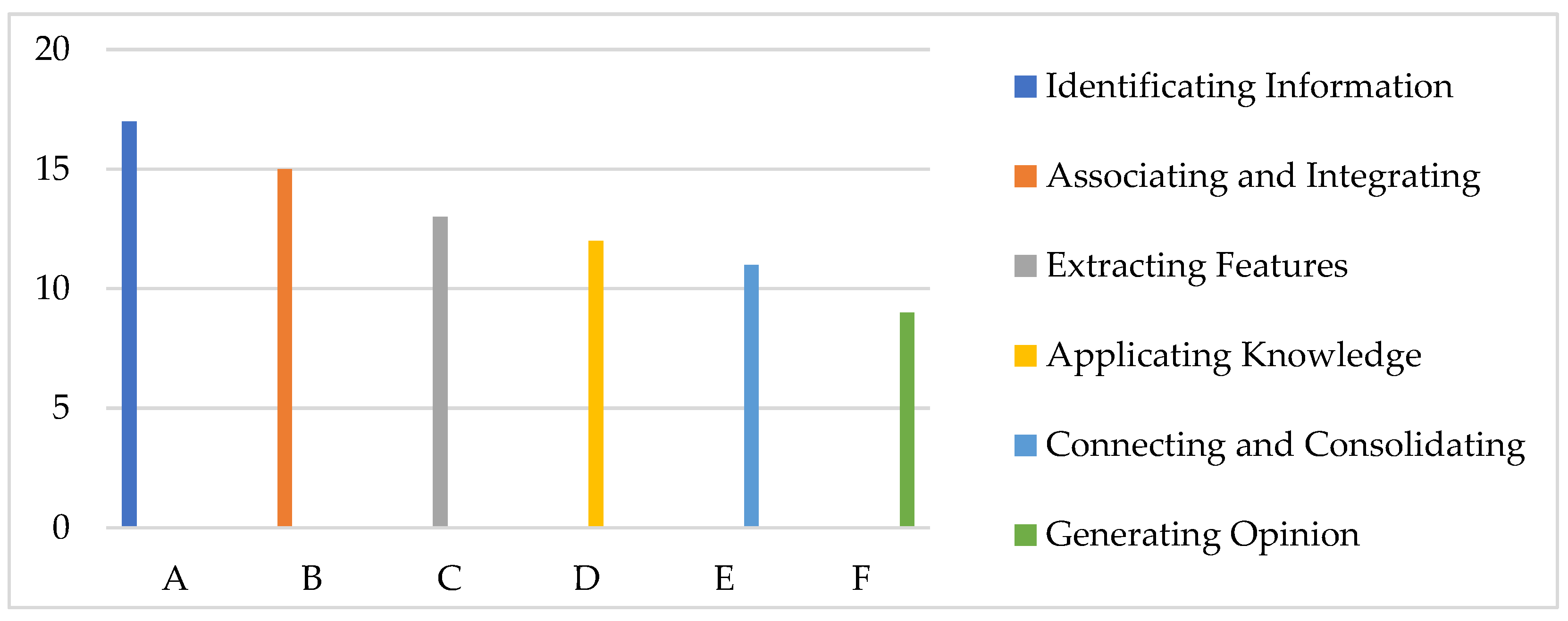

| Basic Information | Characteristics | Teacher | Student | Total |
|---|---|---|---|---|
| Gender | Male | 4 | 8 | 12 |
| Female | 3 | 5 | 8 | |
| Grade | Sophomore year | / | 9 | 9 |
| Junior year | / | 4 | 4 | |
| Number of years of teaching or participating in DBEL | One year | / | 9 | 9 |
| Two years | / | 4 | 4 | |
| Over two years | 7 | / | 7 | |
| Total number | 7 | 13 | 20 | |
| Sample Source Data | Initial Concept | |
|---|---|---|
| S2: I think it’s important that you know what to do and what the details are during the design process. Hands-on skills are acquired, and trial and error are crucial. | T3: During the design process, I will give feedback to students as soon as possible to help them adjust and iterate. | aa10 Students’ hands-on practice aa67 Trial and error |
| S9: I like to participate in design projects. Doing projects gives me a sense of accomplishment. When I finish a project, I feel very happy because I can learn a lot. | T6: Our analog integrated circuit and robotics courses are usually held in the first or second year of junior year. At this stage, students have a lot of practical design content, which is relatively difficult. | aa3 Design project |
| S10: Whenever I have a problem in the learning process, I want to solve it, no matter what the problem is or what the teacher said in class. No matter how many times I try and make mistakes, if I can’t solve them, I will keep thinking until I solve them. | T6: The design process is to iterate through the whole process to stimulate students to consider some underlying practical engineering problems. | aa67 Trial and error aa74 The problem is rectified |
| S12: Making plans with classmates can deepen my impression. When you can explain the whole scheme in its entirety, you will understand the problem very well; If I don’t know how to do it, at this time, other students may come to tell me their thoughts and ideas, which can also help me understand what I didn’t understand before. This process is very effective. | T1: Engineering students should not only have the professional ability but also have the spirit of teamwork. Integration and innovation are very important for engineering students, and these things need students to practice daily communication and cooperation. | aa41 Student exchange and cooperation |
| Core Category | Subcategory | Initial Category | Dimension |
|---|---|---|---|
| Design Practice | Challenging task | Real engineering problems, real project content, challenging tasks | Suitable–Not suitable |
| Hands-on practice | Students do hands-on experiments; students make the finished product by hand | Attention–Neglect | |
| Scheme design | Student participation in program design; students use design methods | Suitable–Not suitable | |
| Interactive Reflection | Peer interaction | Group negotiation, class discussion, group cooperation | Abundant–Deficient |
| Teacher–student interaction | Teachers interact with students; the teacher gives guidance to the students | Abundant–Deficient | |
| Social interaction | Physical interaction in the external environment; school–enterprise interaction in foreign cooperation | Abundant–Deficient | |
| Knowledge Integration | Information recognition | Students understand information; students identify external knowledge | Sufficient–Insufficient |
| Knowledge correlation | Students identify deficiencies in the design process; students promote knowledge understanding; students relate and integrate knowledge points | Sufficient–Insufficient | |
| Opinion generation | Students extract knowledge elements; students generate relevant opinions; students consolidate relevant knowledge | Sufficient–Insufficient | |
| Circular Iteration | Trial and error | Students try and make mistakes along the way | Strong–Weak |
| Scheme iteration | Redesign based on trial and error results; participate in many design cycles and design scheme iterations | Strong–Weak | |
| Result from perfection | Students constantly improve the design products; implement the new learning plan according to the adjustment plan | Strong–Weak |
| Characteristic Dimension | Operational Definition |
|---|---|
| Design Practice | Engineering students participate in real design projects and hands-on solutions to real engineering problems. |
| Interactive Reflection | Engineering students interact with people and products in the process of design practice and seek new perspectives to solve design problems. |
| Knowledge Integration | Engineering students receive external information, integrate internal knowledge, and transform knowledge and information into problem-solving strategies. |
| Circular Iteration | In the process of design, engineering students constantly apply trial and error, iterate, verify the design scheme, and finally, solve the problem. |
| Characteristic Dimension | Operational Coding |
|---|---|
| Design Practice | Engineering students design experiments and optimize the design process and methods |
| Engineering students learn through real projects and challenging assignments | |
| Engineering students carry out hands-on experiments and make finished products | |
| Engineering students apply technology and tools to design engineering problem solutions | |
| Interactive Reflection | Engineering students integrate internal information to generate new ideas |
| Engineering students identify external perspectives and integrate them | |
| Engineering students use multidisciplinary approaches and tools to solve engineering problems | |
| Engineering students integrate theoretical knowledge with practical experience | |
| Knowledge Integration | Engineering students participate in group cooperation and group negotiation |
| Engineering students reflect on the learning process in collaboration | |
| Engineering students share and exchange ideas and generate new ideas | |
| Engineering students share solutions with their classmates | |
| Circular iteration | Engineering students are constantly experimenting with trial and error, trying new solutions |
| Engineering students identify the deficiencies in the design process and constantly improve and practice | |
| Engineering students seek the best solution to improve the learning effect |
Disclaimer/Publisher’s Note: The statements, opinions and data contained in all publications are solely those of the individual author(s) and contributor(s) and not of MDPI and/or the editor(s). MDPI and/or the editor(s) disclaim responsibility for any injury to people or property resulting from any ideas, methods, instructions or products referred to in the content. |
© 2023 by the authors. Licensee MDPI, Basel, Switzerland. This article is an open access article distributed under the terms and conditions of the Creative Commons Attribution (CC BY) license (https://creativecommons.org/licenses/by/4.0/).
Share and Cite
Wei, L.; Zhang, W.; Lin, C. Multidimensional Characteristics of Design-Based Engineering Learning: A Grounded Theory Study. Sustainability 2023, 15, 3389. https://doi.org/10.3390/su15043389
Wei L, Zhang W, Lin C. Multidimensional Characteristics of Design-Based Engineering Learning: A Grounded Theory Study. Sustainability. 2023; 15(4):3389. https://doi.org/10.3390/su15043389
Chicago/Turabian StyleWei, Lina, Wei Zhang, and Chenhua Lin. 2023. "Multidimensional Characteristics of Design-Based Engineering Learning: A Grounded Theory Study" Sustainability 15, no. 4: 3389. https://doi.org/10.3390/su15043389
APA StyleWei, L., Zhang, W., & Lin, C. (2023). Multidimensional Characteristics of Design-Based Engineering Learning: A Grounded Theory Study. Sustainability, 15(4), 3389. https://doi.org/10.3390/su15043389






